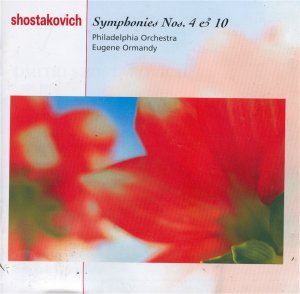The two symphonies are presented cleanly - each with a disc
to itself.
As works, while the Tenth has the ingredients of memorability
inherent in excoriating drama, accessible themes and treatment the Fourth
is more forbidding. You might compare Nielsen's Fifth and Sixth (popular
and enigmatic side by side), Walton 1 and 2, Prokofiev 7 and 6, Rubbra
4 and 8, Braga Santos 4 and 5, Sibelius 2 and 4, Bax 5 and 1. The effect
is similar. Rather as he did with Nielsen 6 (also on Sony Essential
Classics) Ormandy illuminates the Shostakovich Fourth more clearly than
I have heard before.
Shostakovich's Fourth Symphony had to wait a quarter
of a century for its premiere. Fritz Stiedry had the work in rehearsal
with the Leningrad Philharmonic but at this time an attack on his opera
Lady MacBeth of Mtsensk and the purging of his mentor Mikhail
Tukhachevsky dictated that the work be withdrawn. In due time the Fifth
Symphony emerged to Party acclaim. Its overtones of compromise or sarcasm
are still debated but it remains the composer's most famous and most
played symphony. If the Fourth was driven into the shadows by Stalin,
the death of Stalin liberated the Tenth Symphony. Within months of the
dictator's death in 1953 Shostakovich began work on the symphony, starting
it in April and finishing it on 25 October 1953. It was premiered in
Leningrad in 17 December 1953.
If we discount the brilliant but for this listener
unlovable First Symphony, the Fourth was his first absolute symphony;
one without stated programmatic content. No doubt its power to startle
and disconcert was intensified by the contrast with its two predecessors
which had overt Communist content. The Fourth had no such indicators
and their lack, coupled with the strong dissonances in the first movement
(try 12.03 onwards in the first movement) made the work a natural victim
of cultural and political paranoia.
Ormandy and his orchestra give both symphonies laceratingly
virtuosic performances. The playing lacks nothing in garish colour;
snarl and sneer toll relentlessly through the bassoon and oboe lines
at 24.03 of the Fourth Symphony's first movement. The 1963 recording
holds up extremely well especially when compared with results captured
by Russian engineers recording in Moscow and Leningrad at the time.
I was expecting an overly smooth approach purged of jaggedness, cauterising
acid and raw satire. I could not have misjudged the approach more. The
soured and searing Mahlerian Largo-Allegro is, for example, played
with no-holds-barred hysteria, ready charnel-house humour (10.49), joyous
romanticism garnered from Prokofiev's Romeo and Juliet (13.01)
and a quietly contented ostinato which in its less complicated way looks
forward to the haunted ticking of the finale of the Fifteenth Symphony.
Ormandy is savagely exuberant in the Allegro though lacks quite the
slashing bite and scourging cordite of Mravinsky or Kondrashin.
No Shostakovich expert can afford to be without these
recordings which are inexpensively coupled. Ormandy gave the first performances
of the Fourth on the warm side of the Iron Curtain. The Fourth is a
significant recording both as a 'document' put down within months of
the Western premiere and as an interpretation showing Ormandy's DSCH empathy.
Rob Barnett


